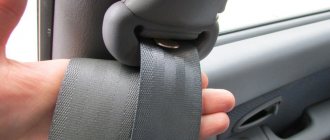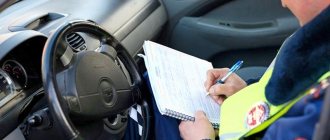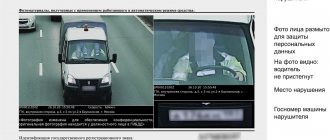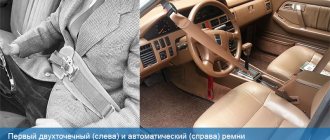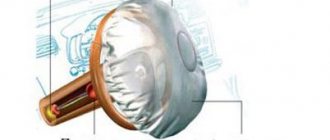What the traffic rules say about seat belts
Chapter 2 outlines the responsibilities of persons driving mechanical vehicles on public roads and regulates the issues of stopping vehicles for inspection and actions in case of an accident. A list of certification and permitting documents is presented, as well as requirements for ensuring safe transportation.
Paragraph 2.1.2 directly defines the mandatory use of seat belts when driving vehicles, both by the driver and all passengers. For two-wheeled vehicles - the presence of fastened helmets.
Passenger responsibilities are set forth in clause 5.1. Their presentation begins with the requirement of the unconditional use of seat belts, if available, and when riding a motorcycle, the use of protective helmets.
Grounds for imposing a fine
It is not only the driver who has the obligation to use passive protection. A decision is made on an administrative penalty with a fine if a seat belt is not used:
- The driver or he is not fixed with a special device.
- Passengers, if they are provided for by the design of the vehicle.
- For children or, for the corresponding age group, with a mandatory additional seat, when the latter is not available.
Attention! How much a fine will be imposed for not fastening seat belts is determined for each case of violation separately.
Video on how to appeal a seat belt fine
After large-scale changes that were made to the rules of the road, the use of seat belts has become mandatory not only for the driver of the car, but also for his passengers. If previously most cars were not even equipped with such fasteners for those people sitting in the back seat, now this requirement is imposed on all vehicle manufacturers.
Wearing a seat belt can save a person's life during a collision or other emergency. That is why traffic police officers monitor the implementation of this rule of law. If they reveal a violation, the guilty person will be brought to administrative responsibility. Therefore, many motorists are interested in whether it is possible to appeal a fine for not fastening a seat belt and how to do it.
Fines for not wearing a belt
The measure of responsibility is determined by the provisions of Art. 12.6 and 12.29 Code of Administrative Offences. The first prescribes a fine of one thousand rubles from the driver for not fastening their seat belts in 2021, and the second - from the passenger for violating their duties - 500 rubles or a warning.
When a fine is imposed for an unbelted child, several age groups and the conditions of the offense are taken into account:
- a child under seven years of age must be transported using a certified restraint device;
- from seven to twelve years of age, children can ride in the back seat in special seats or fastened with seat belts equipped with adapters;
- When children twelve years of age and older are in the car, general rules apply.
If the established procedure for transporting children is violated, the driver is responsible, and during organized group trips - the officials and legal entities that provided the vehicles. Article 12.23 of the Code of Administrative Offenses provides for fines of 3,000, 25,000 and 100,000 thousand rubles, respectively.
Advice! If traffic police officers did not video record the offense, it will not be possible to challenge the decision on this basis - for an administrative penalty, it is enough to reflect the event in the protocol.
Fines for not wearing a seat belt
The Code of Administrative Offenses considers the following situations as violations:
- if the driver is not wearing a seat belt;
- if the protective device is not used by passengers;
- if a child under twelve years of age is transported in violation of the above requirements.
Below you will learn how to appeal a seat belt ticket. It must be borne in mind that responsibility for everything that happens in the car primarily rests with the driver. Therefore, it will bear negative consequences in any case, even if violations were committed by passengers. Thus, the law establishes that if there are unfastened passengers in the cabin or the driver himself does not use a belt, then a fine of one thousand rubles is imposed on him. Moreover, the amount of the penalty is not affected by the number of unbelted persons, and even if there are three passengers in the cabin, the fine will still be a thousand rubles. But at the same time, repeated prosecution is allowed within one day. Thus, during the journey, traffic police officers can repeatedly stop the car, and if any of the people in it are not wearing a seat belt, then a fine is issued separately for each fact.
How to avoid deprivation of rights for refusing a medical examination.
If passengers do not use protective devices, they will be subject to a fine of five hundred rubles. Moreover, if there are several persons in the cabin who have violated the requirements of the law, then a separate protocol is drawn up for each passenger. Also, the traffic police officer may limit himself to a verbal warning.
The most significant fine is provided for moving children in violation of established rules. Therefore, it is in connection with this violation that the question most often arises of how to challenge a traffic police fine for a seat belt. It should be noted that in this case the driver is punished, even if he is not the child’s parent. A fine of three thousand rubles is imposed on him. The child is not subject to liability, since the minimum age for involvement under administrative law is sixteen years.
Are rear seat passengers fined for not wearing seat belts?
There is a common belief that passengers in the rear seats do not have to wear seat belts – for example, in a taxi. This is not true. Paragraph 2.1.2 of the traffic rules applies to all persons in the cabin of a moving car, and therefore a protocol will be drawn up for each passenger.
The rear row is removed from the front airbags, protection is provided only by the backrest of the seat in front and the belt. In many cases, an unfastened “rear” passenger on the highway during an accident flies out into the windshield, and begins to receive injuries while still inside the cabin on the body of the car.
If a passenger in the back seat has ignored the requirement of the rules, then he will be punished under Article 12.5, where the fine for wearing a seat belt in 2021 provides for the amount of 500 rubles while simultaneously collecting 1000 rubles from the driver for failure to ensure the safe transportation of people.
Responsibility for broken belts
Driving a vehicle or transporting passengers with a non-functioning passive injury prevention system entails liability under Article 12.5 of the Code of Administrative Offenses. The fine for a broken seat belt in 2021 in Russia is 500 rubles. The same amount of sanctions awaits the driver if they were dismantled on his own initiative or when circumstances beyond his control arose, but were provided for by the design of the car.
It is important to know! If belts are ignored or malfunctioning, the deployment of airbags even in a minor accident increases the risk of injury - the body is not fixed, which makes the contact area between the person and the protective shell unpredictable. On many foreign-made cars, when the belt is disconnected, it simply does not work.
Who shouldn't wear a seat belt?
Many drivers believe that they do not have to wear a seat belt at all. Let us recall that previously, paragraph 2.1.2 of the traffic rules allowed driving a car without seat belts to three categories:
- car instructors with a student behind the wheel;
- employees of state fiscal and operational services when performing duties in special vehicles with appropriate cartographic markings and identification marks;
- drivers with disabilities.
In 2010, PP No. 316 amended the provisions of the traffic rules, including those relating to the wording of paragraph 2.1.1. In accordance with them, the part allowing individual drivers to drive without seat belts has been abolished. Today, all persons driving vehicles equipped with seat belts are required to comply with the provisions of Article 2.1.2 without exception.
Information about the consequences of violating the safety requirements of people in the car while driving, as well as what fine for not fastening a seat belt in 2021 is provided for by the provisions of the Code of Administrative Offenses, will allow the driver to once again assess the consequences of neglecting compliance with traffic rules.
How to prove that a seat belt was fastened?
“What is the evidence that I was driving without a seat belt?” In simple terms, the traffic police inspector does not have to prove anything: it is enough that he saw the driver driving with his seat belt unfastened. In the Code of Administrative Offences, this is formulated as follows: “The reason for starting an administrative process is the direct detection of signs of an administrative offense by the body conducting the administrative process.” However, let’s not forget about the presumption of innocence: “The circumstances set out in the protocol on an administrative offense, in the decision to impose an administrative penalty, cannot be based on assumptions. Doubts about the validity of the conclusion about the guilt of the person against whom the administrative process is being conducted are interpreted in his favor.” This means that a traffic police officer cannot simply declare that the seat belt was not fastened. He must not only HAVE THE OPPORTUNITY to see the fact of the offense, but also actually SEE it. It is on these positions that the defense of your position is based in case of disagreement with the accusation against you under Part 4 of Article 18.12 of the Administrative Code. Alexander Starichenko discusses what may be sufficient evidence that you were driving with unfastened seat belts or transporting unfastened passengers: - Structurally, belts consist of two parts: the belt itself, attached to the side elements of the car body and having a special tongue, and a lock, into which the belt tongue is inserted and which is located between the seats of the two front seats at approximately a distance of 30 centimeters from the floor of the cabin. Now let's ask ourselves when the seat belt will be considered fastened. Obviously, when the belt tongue is inserted into the lock. Accordingly, when the lock is empty and there is no tongue in it, the belt will be unfastened. Thus, in order to clearly state a violation, the traffic police inspector must clearly see at least one of the following at the moment of movement: 1. The lock. 2. Belt tongue. 3. The belt itself, not thrown over the torso of the driver or passenger towards the lock. It is almost impossible to see the belt lock and tongue while the car is moving. The most common situation is when a traffic police inspector, stopping a car to check documents, draws attention to unfastened seat belts. At the same time, the arguments that the belt was removed after stopping the vehicle in order to get documents (open a window, etc.) do not have any impact on the inspector; he issues a decision on administrative liability. If you do not agree and are ready to defend your rights, then you need to collect evidence right on the spot indicating your innocence.
1. Find witnesses who will confirm that you were wearing your seat belt while driving and unfastened it after stopping. As a rule, these are the passengers in your car. 2. Record the distance that was between you and the traffic police inspector at the moment when you received a request from him to stop, as well as at the moment when you stopped. The greater these distances, the less likely it is that the inspector was able to see anything related to the seat belts. 3. Record the location of the inspector at the moment when he gave you the signal to stop. 4. Record the time and weather conditions in which the stop was made. It is known that in the dark, visibility is significantly reduced. Visibility is also limited during rain or snow. 5. Determine whether there was artificial lighting on the road (whether street lights were on) if the stop was made in the dark. 6. Record the color of the outerwear you were wearing. If the color of the clothing is close to the color of the belt, the chances of seeing it decrease as the distance increases. 7. Fix the presence of a gap between the shoulder and the upper side fastening of the belt. If your fit or build is such that such a gap is either minimal or absent (for example, taking into account outer clothing in winter), the inspector’s chances of proving that he saw in the open light the absence of a belt going towards the lock also rapidly decrease. 8. Record whether your car has tinted windows or not. 9. It is advisable to separately draw up, based on the data from points 2-4, a stopping diagram indicating the corresponding distances. You can provide the collected evidence when appealing the decision to impose an administrative penalty against you. Natalya ZHURAVLEVICH ABW.BY Do you have questions? We have the answers. Topics that interest you will be expertly commented on by either specialists or our authors - you will see the results on the website abw.by. Send questions to [email protected] and monitor the site.

